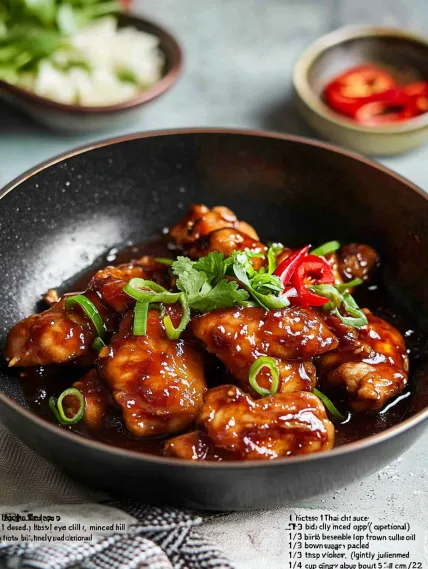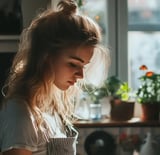 Pin
Pin
This hearty Vietnamese Caramel Ginger Chicken has been my weeknight savior when I crave something bold and satisfying without hours in the kitchen. The tantalizing balance of sweet caramel, savory fish sauce, and zingy ginger creates a glaze that transforms simple chicken into something extraordinary.
I first made this during a particularly hectic week when I needed something quick but didn't want to sacrifice flavor. The caramelization process filled my kitchen with such an intoxicating aroma that my family now requests it weekly.
Ingredients
- Chicken thigh fillets: Cut into large pieces; the dark meat stays juicy while developing that beautiful caramel color
- Fish sauce: Provides that unmistakable umami depth that forms the backbone of Vietnamese cuisine
- Brown sugar: Creates the foundation for the caramel sauce; look for one with good moisture content
- Fresh ginger: Julienned finely, gives essential warmth and aromatic punch
- Bird's eye chilli: Adds a perfect kick of heat but can be adjusted to your preference
- Eschallots or red onion: Provide subtle sweetness that balances the sauce
- Vegetable oil: Helps create the caramel base without burning
- Boiling water: Helps control the cooking process while allowing flavors to meld
How To Make Vietnamese Caramel Ginger Chicken
- Marinate the Chicken:
- Toss your chicken pieces with fish sauce and minced chilli, if using. The fish sauce starts tenderizing the meat immediately while adding deep umami notes. Even a quick 10-minute marinade makes a difference, though you can leave it overnight for deeper flavor.
- Create the Caramel Base:
- Combine oil and brown sugar in a cold large nonstick pan, then heat over medium-high. Watch carefully as the sugar melts completely, becoming a bubbling amber liquid. This creates the foundation for the entire dish, so be attentive without letting it burn.
- Add Protein and Aromatics:
- Remove pan briefly from heat for safety, then add chicken, ginger, and shallots. The caramel may temporarily harden but will remelt quickly. Stir just until chicken turns white on the exterior but remains uncooked inside. This staging ensures the meat stays tender.
- Simmer to Perfection:
- Add boiling water and return to a vigorous simmer. This critical step requires patience as the liquid reduces significantly, becoming a glossy glaze that coats each piece of chicken. Use a large pan and maintain a rapid simmer to speed this process. The transformation is magical as the sauce concentrates.
- Glaze and Caramelize:
- As liquid reduces, toss chicken pieces more frequently. The sauce will transition from watery to syrupy, finally becoming a rich, shiny coating. Push this process until chicken develops beautiful caramel color. The deeper the color, the more complex the flavor.

Ginger is truly the star ingredient here. I still remember the first time I made this dish for my Vietnamese friend who closed her eyes and said it reminded her of her grandmother's cooking. There's something about the way ginger mellows and sweetens in the caramel that creates pure comfort.
Storage and Reheating
This chicken actually improves overnight as the flavors deepen and meld. Store leftovers in an airtight container in the refrigerator for up to 3 days. When reheating, add a tiny splash of water to revive the sauce and heat gently, either in a skillet or microwave, until just warmed through. The caramel sauce tends to thicken significantly when cold but will loosen beautifully upon reheating.

Perfect Pairings
The rich, complex flavors of Vietnamese Caramel Ginger Chicken call for simple accompaniments. Serve over steamed jasmine rice, which provides the perfect neutral canvas to soak up the delicious sauce. For a complete meal, add a cooling element like cucumber salad or some quickly stir-fried greens like bok choy or gai lan. The traditional Vietnamese approach would include some pickled vegetables for brightness and contrast.
Cultural Context
Caramel sauce, or "nước màu," forms the base of many classic Vietnamese dishes. Originally developed as a practical cooking method in a country where sweeteners were precious, this technique transforms simple sugar into a complex flavor agent with remarkable depth. The addition of fish sauce creates "nước mấm," the sweet-savory backbone of Vietnamese cuisine. This particular dish represents home cooking at its finest— not fancy restaurant food, but the kind of satisfying meal found in households throughout Vietnam.
Troubleshooting Tips
If your sauce isn’t reducing properly, there are a few possible fixes. First, ensure your pan is truly large enough; as mentioned, a 12-inch pan is ideal. Second, check your heat level; the simmer should be vigorous enough that you see constant bubbling across the surface. Finally, if you’re still struggling, transfer the chicken to a plate using a slotted spoon and reduce the sauce separately until it reaches a syrupy consistency, then return the chicken to coat it thoroughly.
Recipe FAQs
- → What type of chicken is best for this dish?
Skinless chicken thigh fillets are recommended because they are more tender and flavorful. However, chicken breast can also be used if preferred.
- → How do I ensure the caramel forms properly?
Use a large non-stick pan and ensure the sugar and oil mixture is melted before adding the chicken. Rapid simmering helps reduce the liquid to a glaze.
- → Can I make this dish spicy?
Yes! Add finely minced bird’s eye chilli or Thai chilli to the marinade, or sprinkle freshly sliced chilli on top when serving.
- → What sides go well with this dish?
It pairs wonderfully with jasmine rice or plain steamed rice. For sides, try smashed cucumbers, Asian slaw, or sautéed greens.
- → Can I prepare this dish in advance?
The chicken can be marinated overnight for extra flavor, but the dish is best served fresh as the glaze retains its texture. Leftovers can be reheated gently on the stove.
- → What should I do if the sauce isn’t reducing?
Use a larger pan and increase the heat to a rapid simmer. Remove chicken temporarily to speed up the sauce reduction if needed.
